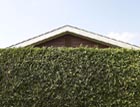Creating privacy in the garden
Roddy Llewellyn suggests filling any gaps in winter hedgerow with the hermaphrodite holly


Ivy, especially the common ivy Hedera helix, is sometimes considered to be a tiresome and destructive plant, and indeed it can become so when allowed to grow in the wrong place, or if it's not looked after properly. The main reason why I'm loath to get rid of ivy is because it's so highly prized by conservationists the flowers are a favourite of honeybees, as they supply much needed late summer/autumn nectar. The established foliage is a popular cover and nesting place for many garden birds, such as thrushes, robins and blackbirds. Many insects will set up home there, too. It's only when ivy is allowed to romp away out of control that it can become troublesome. I've noticed in the hedgerows of my neighbourhood that established ivy has been cut at the base of mature tree trunks. This, of course, results in all growth above the cuts dying off.
It can take a season or two to brown, and when it does, you can easily pull it away, like damp wallpaper. Dead ivy at the top of a tall tree will eventually be blown free of the branches by the wind. If ivy is left unchecked to grow to the top of a wall or tree, it becomes 'arboreal', whereupon the leaves change shape, and flowers and fruiting spurs appear; the host tree can die through light deprivation. It's never a good idea to grow ivy up a dry-stone wall. Having found its way through the wall, the stem expands and, as it does so, forces the stones apart. It's quite safe, however, on a stone or brick wall, as long as the mortar is sound. Some people don't seem to mind about their gardens being open to public gaze. It's always struck me as being very odd the way famous stars in Hollywood leave their front gardens and house totally visible from the road. I really rather hate the idea of being seen in my garden by total strangers. It's not as if I'm in the habit of doing anything indecent as I potter about, it's just that I want to potter in private. My new garden is hedged in, for the most part by blackthorn, lovely in the spring and summer, but see through and charm free in winter.
Two usurpers have self-seeded among the blackthorn: a common elder and a sycamore, both unpopular inmates as far as I'm concerned, because of their vigorous growth that weakens practically all else in their path. Having cut them back almost to the ground, I shall now kill them with my flowerpot trick (I place a large plastic flowerpot over the stumps for a growing season, weighed down with a heavy stone; it's a method that eliminates any need of chemicals). I plan to put evergreens in the gaps they leave behind, as well as in other places where the blackthorn growth is weak, having first removed some of the lower branches of the trees within the hedge.
The choice of further plants will be dictated by the nature of the garden's rural setting, surrounded as it is by country lanes. Common holly is an obvious choice, although there is no way of establishing their sex as small plants, or even as larger ones for that matter, until the females only start to bear berries, and there has to be a male close by whose pollen can safely be blown in the ladies' direction at flowering time in spring. There is a widely available hermaphrodite holly, known as Ilex aquifolium J. C. van Tol, with plain green leaves. He/she might do for my hedge, owing to his/her ability to produce an abundant crop of red berries. Who is/was J.C. van Tol, I wonder? Continuing on the same rustic theme, I'll also include common yew and common box, both of which will be able to cope with the existing semi-shaded conditions. The addition of an occasional splash of evergreen in winter will help cheer things up a bit and succeed in giving me more privacy.
Exquisite houses, the beauty of Nature, and how to get the most from your life, straight to your inbox.
Country Life is unlike any other magazine: the only glossy weekly on the newsstand and the only magazine that has been guest-edited by His Majesty The King not once, but twice. It is a celebration of modern rural life and all its diverse joys and pleasures — that was first published in Queen Victoria's Diamond Jubilee year. Our eclectic mixture of witty and informative content — from the most up-to-date property news and commentary and a coveted glimpse inside some of the UK's best houses and gardens, to gardening, the arts and interior design, written by experts in their field — still cannot be found in print or online, anywhere else.
-
 What on earth is the person who comes up with Annabel's otherworldly facade displays on? London's most magical Christmas shop displays
What on earth is the person who comes up with Annabel's otherworldly facade displays on? London's most magical Christmas shop displaysPhotographs by Greg Funnell.
-
 What trees taught me about perfect planting — Alan Titchmarsh
What trees taught me about perfect planting — Alan TitchmarshSense and patience is key to growing healthy trees, as a certain Mr Mackenzie showed a young Alan Titchmarsh
